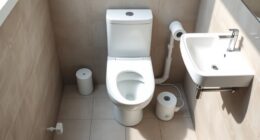Have you ever thought about where toilet water ends up?
We’re here to give you the lowdown on the flushing process. From the intricate plumbing infrastructure to the vast network of municipal sewage systems, we’ll explore the journey your wastewater takes.
But it doesn’t end there!
We’ll also dive into the world of wastewater treatment plants and the important role they play in ensuring our environment stays clean.

Get ready to master the mysteries of toilet water disposal.
Key Takeaways
- Flushing the toilet initiates a series of events that clean the bowl and conserve water.
- The dual flush system helps reduce water consumption and is eco-friendly.
- Municipal sewage systems collect wastewater through an underground network of pipes, which is then transported to treatment plants for processes to remove contaminants.
- Treated wastewater can be recycled and reused for purposes such as irrigation and industrial use, helping to mitigate water scarcity issues.
The Flushing Process
During the flushing process, we push the lever to send the toilet water down the drain. This action initiates a series of events that efficiently clean the toilet bowl while also conserving water.
As we push the lever, the flush valve opens, allowing water to flow from the tank into the toilet bowl. The water then creates a siphoning effect, which effectively removes waste and cleans the bowl’s surfaces. This process ensures that the toilet bowl remains hygienic and free from any residue.
Additionally, water conservation is achieved through the use of a dual flush system, which allows users to choose between a partial or full flush depending on their needs. This feature helps reduce water consumption, making it an eco-friendly choice for households.

Plumbing Infrastructure
Now let’s delve into the plumbing infrastructure that allows toilet water to flow smoothly through the system. The plumbing infrastructure consists of a series of interconnected pipes and fixtures designed to transport and dispose of waste water efficiently and safely. It plays a crucial role in maintaining water conservation and ensuring water quality.
To achieve water conservation, plumbing systems incorporate various features such as low-flow toilets and faucets. These fixtures are designed to reduce water usage without compromising performance. Additionally, modern plumbing systems may include water-saving technologies like greywater recycling systems, which reuse water from sources like showers and sinks for non-potable purposes like irrigation.
Water quality is another important consideration in plumbing infrastructure. Properly designed and maintained plumbing systems prevent contamination and maintain the integrity of the water supply. This includes using materials that are resistant to corrosion and bacteria growth, as well as implementing effective filtration and treatment systems to remove impurities.
Municipal Sewage Systems
To understand the journey of toilet water, we must explore the role of municipal sewage systems. These systems play a vital role in managing and treating wastewater from households and businesses. Municipal sewage systems are governed by strict municipal regulations that ensure the proper handling and disposal of sewage.

They’re designed to collect wastewater from various sources through a network of underground pipes. Once collected, the wastewater is transported to a treatment plant where it undergoes a series of processes to remove contaminants and pollutants. These treatment plants are equipped with advanced technologies to ensure efficient treatment and water conservation.
The treated water is then discharged into water bodies or reused for irrigation, depending on local regulations and water conservation efforts. Municipal sewage systems are crucial for maintaining public health and protecting the environment.
Wastewater Treatment Plants
At wastewater treatment plants, we use advanced technologies to remove contaminants and pollutants from collected wastewater. The main goal of these plants is to purify the water and make it safe for reuse or to be discharged back into the environment.
Water purification is achieved through a series of processes that target different types of pollutants. Firstly, we remove large solids through a process called screening, followed by sedimentation to settle out smaller particles. Then, the water undergoes biological treatment, where microorganisms break down organic matter. Finally, the water is disinfected to kill any remaining harmful bacteria or viruses.

Once the water is purified, it can be reclaimed for various purposes such as irrigation, industrial use, or even drinking water in some cases. Wastewater treatment plants play a crucial role in protecting public health and the environment by ensuring that water resources are properly managed and conserved.
Environmental Impacts
Once the water is purified at wastewater treatment plants, it undergoes a series of checks to assess its environmental impacts. These checks are crucial in determining the quality of the treated water before it’s released back into the environment.
One of the main concerns is water pollution, as untreated or improperly treated water can contain harmful pollutants that can harm aquatic ecosystems and human health. By conducting rigorous tests, such as measuring the levels of nutrients, heavy metals, and organic contaminants, we can ensure that the treated water meets the required standards.
Additionally, resource depletion is another environmental impact to consider. Wastewater treatment plants often use large amounts of energy and chemicals in the purification process, which can contribute to the depletion of natural resources. Therefore, it’s important to continuously evaluate and optimize these processes to minimize their environmental footprint.

Frequently Asked Questions
What Are the Different Types of Toilets and How Do They Affect the Flow of Toilet Water?
There are different types of toilets that can affect the flow of toilet water. Understanding these types can help us optimize water usage and ensure efficient plumbing systems in our homes.
Are There Any Health Risks Associated With Using Toilet Water in the Flushing Process?
There are health risks associated with using toilet water in the flushing process. However, with proper maintenance and disinfection, these risks can be minimized. Regular cleaning and using appropriate cleaning agents are crucial for maintaining a hygienic flushing system.
How Do Septic Systems Differ From Municipal Sewage Systems in Handling Toilet Water?
Septic systems and municipal sewage systems differ in handling toilet water. Septic tanks treat waste on-site, separating solids from liquids. Liquids are released into a drain field while solids are broken down by bacteria. Municipal systems transport waste to a centralized sewage treatment plant for processing.
Can Toilet Water Be Reused for Other Purposes, Such as Irrigation or Industrial Processes?
Toilet water can be reused for irrigation or industrial processes through toilet water filtration systems. This method promotes toilet water conservation and reduces the strain on freshwater resources.

What Are Some Innovative Technologies Being Developed to Minimize the Environmental Impact of Toilet Water Disposal?
Innovative technologies are being developed to minimize the environmental impact of toilet water disposal. These advancements aim to optimize water treatment processes, enhance resource recovery, and reduce energy consumption, ultimately creating a more sustainable and efficient system.
Conclusion
In conclusion, understanding the journey of toilet water from the flushing process to its treatment at wastewater plants is crucial for a sustainable environment.
Did you know that in the United States alone, over 32 billion gallons of wastewater are treated every day? This staggering statistic highlights the immense scale of wastewater management and the importance of effective systems to protect our ecosystems and public health.










